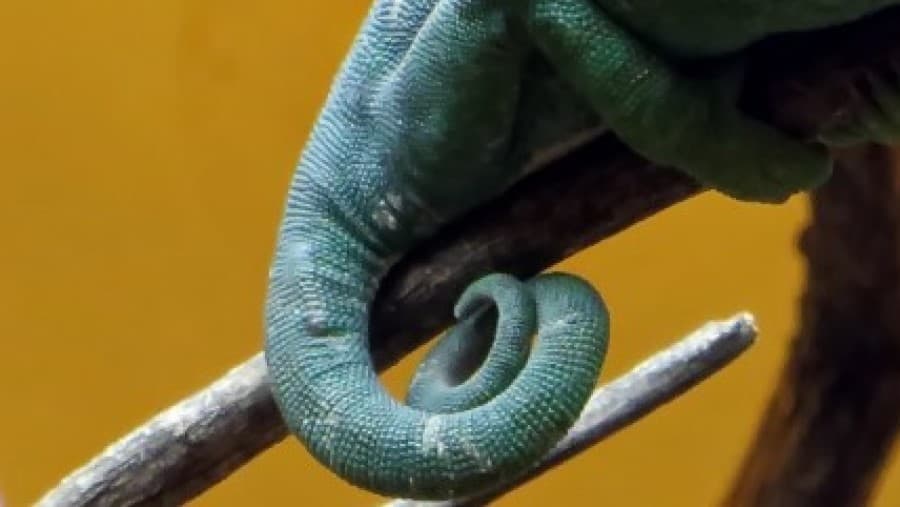
You may have wondered, do chameleons drop their tails like some lizards? It is a very curious question, especially for a new chameleon owner. Do chameleons have the ability to drop their tails?
Chameleon cannot drop their tails as they lack a vertical fracture plane. This means their tails have bones. Hence, even in a situation of threat or danger, a chameleon would not drop its tail. However, there are instances when chameleons could lose their tail, for good.
Unlike some other lizards, chameleons can’t drop their tails as a defensive mechanism. However, chameleons can lose their tails under certain circumstances, but it’s never done voluntarily.
Why Can’t Chameleons Drop Their Tails?
Self-amputation or autotomy is a defense mechanism some insects or animals use to actively break a limb off the body. Unfortunately, for chameleons, this is not possible.
Autotomy is formed by the vertical fracture plane, containing absolutely no bone. This allows some lizards to detach their tails.
However, for chameleons, the fracture plane is replaced by bones as the chameleon grows and matures. This phenomenon allows chameleons to have a stronger and more solid tail as they become adults.
Chameleons rely on their tails for balance, movement as well as climbing branches. Hence, the bone on the tail section is made to be strong and durable, allowing chameleons to be able to support their entire body weight on their tails alone.
What Could Cause A Chameleon To Lose Its Tail?
Having your Chameleons cannot drop their tails, however, they are capable of losing their tail in some situations.
Bitten Off
It is quite unusual to see a chameleon with a tail that’s been bitten. Nevertheless, there are 3 ways this could possibly happen to your chameleon. Although the chances of this happening are higher in the wild, it is also possible for it to transpire under your watchful eyes in captivity.
Battle with Another Chameleon
Chameleons are a very territorial species. They would get aggressive and jump into battle if they feel their territory is under threat. Sometimes during these battles, they might get their tails bitten.
If a bitten tail isn’t immediately looked at, it could lead to more complications and might need to have the tail amputated. This is more common in the wild compared to chameleons in captivity.
However, if you ever made the mistake of putting two or more chameleons in the same cage and had one of the chameleons with a bitten tail, it’s best to take it to a vet at the nearest availability.
Chameleons should never be put in the same enclosure in the very first place. So make sure to also store the chameleons in separate enclosures immediately.
Predators
As we are well aware, chameleons are in the middle of the food chain. Hence, in the wild, there are lots of predators looking to harm them. Chameleons could incidentally lose their tails when it is under attack by a predator.
As previously mentioned, chameleons can’t drop their tails. Nonetheless, a predator could try to grab the chameleon by its tail and cause it to tear off.
Other than that, the predator could also bite into the tail and ripping it off the chameleon. This will never happen to a pet chameleon in captivity as they are usually kept in safe enclosures, alone.
Self-Harm
If you reckon that the above criteria don’t really relate to a caged chameleon, then this does. Chameleons like their own space and when their space to roam around aren’t sufficient, they tend to get worked up.
In many instances, this has led to the chameleon biting on its own tail. When chameleons are kept in small enclosures, they would sometimes confuse their own tails to be a foreign object.
Chameleons then tend to bite their own tails and sometimes to the extent that it would need to be amputated. If you notice that your chameleon is chewing on its own tail, take it to a vet right away if you can.
Not to forget, you will also need to change the cage to a bigger and more spacious one to prevent your chameleon from chewing on its tail again.
Broken Or Damaged
Chameleons are very fragile creatures, to say the least. Their long curled up tails are very easily caught in the wrong places.
Given the nature of their tails with a small pointy end, it’s easy to see why we, chameleon owners, could also cause their tails to be broken or damaged.
Chameleons mainly use their tails to grab onto branches or cage bars for balance, especially if it’s about to shoot its tongue out. Therefore, it is very important to handle our chameleon with care.
You need to make sure its tail is not grabbing on to anything before picking it up. Otherwise, you risk breaking the bone in the tail, or even worst, ripping the tail apart.
It is also very important to watch the enclosure’s entrance when we are opening or closing it. Given how small the end of chameleons’ tails are, it is very easy for us to overlook it and shut the entrance, accidentally causing the tail to be sandwiched and damaging it.
The most common yet accidental way of a pet owner damaging the chameleon’s tail is by stepping on it. We might not realize the extent of the damage unless we start focusing on the chameleon’s tail movement after the accident.
Chameleons often curl their tail into a tight ball when resting. Then again, with a damaged tail or broken tail bone, the chameleon would not be able to complete this curled tight ball with its tail.
Hence, it is essential to look out for this condition to know if your chameleon has a damaged tail and needs to be taken to the vet immediately.
Amputation
Speaking of vets, they are one of the main reasons your chameleon could lose its tail. When you take your chameleon to the vet with an injured tail, the vet might decide to amputate it.
This will depend on the severity of the damages on the tail. In most instances, the vet would try to heal the chameleon’s tail without amputating it if possible. However, if the injury is too serious, then amputation would be the best option for your chameleon.
Can Chameleons Survive Without Their Tails?
Even though their tails are very important and crucial to their survival as they depend on them for balance, the ability to hang onto branches, as well as climbing trees, they can still continue to survive without their tails.
Nevertheless, in an extreme case whereby the chameleon has completely lost its tail, it could still be alive. The chameleon could still live on with a full life ahead even without a tail, especially in captivity.
Out in the wild, they might struggle and that could slowly lead to their demise. This is because a wild chameleon without its tail makes it susceptible to attacks from predators and also other chameleons.
Conclusion
Chameleons can’t drop their tails as they do not have a verticle fracture plane. Without the vertical fracture plane, the chameleon simply can’t detach its tail as the common lizard does.
In return, the bones that are formed in place of the vertical fracture plane strengthen the chameleon’s tail section and allow it to depend more on the tail.
Even though chameleons can’t drop their tails there are certain circumstances in which they could lose their tails. Chameleons, especially in captivity, have a good chance to survive without their tails but might struggle in the wild.
It is important that I remind you, if you see your chameleon with an injured tail or that it could not curl its tail into a tight ball, then do visit the vet as soon as possible.
Although your pet chameleon could live without its tail, you still take care of it and do everything you can to prevent your chameleon from losing it.

